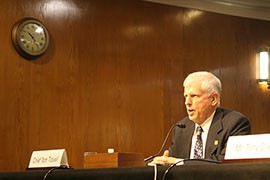- Slug: BC-CNS-Fire Funds,700
- File photos available (thumbnails, captions below)
By JOE GILMORE
Cronkite News
WASHINGTON – The U.S. Forest Service faces a $970 million budget cut in 2018, but the chief of the agency told a Senate panel Wednesday he is confident the service will have the resources to battle wildfires next year.
Chief Tom Tidwell acknowledged that President Donald Trump’s fiscal 2018 budget plan proposes “very difficult reductions in some very important programs,” but said that it will let the service focus on the “highest-priority work” and “support our states.”
But Tidwell’s testimony to a Senate Appropriations subcommittee was questioned by some senators, one of whom called the Forest Service’s budget “a wreck.”
A report by the Department of Agriculture, the Forest Service’s parent agency, said that while the service dedicated just 16 percent of its 1995 budget to firefighting, that grew to 52 percent of its budget in 2015 and is expected to rise to 67 percent by 2025.
Tidwell said President Donald Trump’s fiscal 2018 budget will provide the resources “that are necessary for us to maintain our success rate of suppressing 98 percent of our fires during the initial attack.”
The proposed budget is a mixed bag for the agency. While Trump’s budget would cut the overall Forest Service budget by $970 million next year, it also calls for an increase of almost $500 million to the agency’s Wildland Fire program.
That could be offset elimination of the $821 million “FLAME fund,” a reserve wildfire-fighting fund. The White House budget would also cut 72.5 percent – or $263.8 million – of the Capital Improvement and Maintenance program, which the Forest Service has routinely tapped along with other programs when it runs short of money in the wildfire-fighting budget.
Rep. Raul Grijalva, D-Tucson, said at a separate event Wednesday that the Forest Service budget proposed by the White House is “robbing Peter to pay Paul.”
Tidwell said the agency’s current 10-year average funding model, which averages firefighting costs from the previous 10 years to make budget forecasts for the next year, is working well.
But Sen. Tom Udall, D-New Mexico, said that the budget generated under the 10-year plan “is not enough to fully fund actual firefighting needs in the most recent fiscal years and frequently leads to the agency running out of funds and being forced to borrow from other programs.”
Sen. Jon Tester, D-Montana, said Tidwell can’t be shy.
“When you come to committees like ours, and I know it’s tough to speak truth to power, but you need to tell us, ‘This isn’t working,’” Tester said during the hearing.
“You need to tell us, ‘I don’t have the money for road maintenance because we’re spending it all on fighting fires.’ We know it, we smell the smoke every year in Montana,” he said.
When asked directly how the 2018 budget would impact trail maintenance and other capital improvement programs, Tidwell said the agency will “ensure we maintain our staff and expertise” so the service is “ready to respond to an infrastructure plan.”
That was little comfort to Grijalva.
“A lot of the money that’s coming out of the Forest Service goes to fire suppression as it is right now,” Grijalva said. “We’re always robbing from the Forest Service budget that can do other things in order to suppress fires, and this budget that Trump proposed, in fact, reduces the overall forest service budget, which then reduces the ability to fight forest fires.”
Tidwell said he would like to see a long-term “fix to dealing with fire funding,” and that the sooner lawmakers find that fix, the “sooner you have more flexibility to provide funding to address the needs of your constituents.”
One possible solution floated by Tidwell and some senators would be treating the most dangerous fires as natural disasters.
“It’s really now 1 percent of fires that contribute often to 20 or 30 percent of our costs,” Tidwell told the subcommittee.
He said after the hearing that treating large wildfires like other natural disasters, “not unlike an earthquake or a hurricane or a flooding,” the service would be “able to fund the cost of that 1 percent of fires in a different way versus having that to be part of your annual appropriations.”
– Cronkite News reporter Nathan J. Fish contributed to this report.
^__=
Web links:
_ Department of Interior Report: https://www.fs.fed.us/sites/default/files/2015-Fire-Budget-Report.pdf
_ United States Department of Agriculture budget: https://www.usda.gov/sites/default/files/documents/USDA-Budget-Summary-2018.pdf
_ Tidwell testimony: https://www.appropriations.senate.gov/imo/media/doc/060717-Tidwell-Testimony.pdf
^__=
Forest Service Chief Tom Tidwell testifying in a 2015 file photo. Tidwell told a Senate committee Wednesday that he is confident his agency will be able to respond to wildfires next year, despite sharp budget cuts proposed by the Trump administration. (Photo by Miranda Leo/Cronkite News)
A firefighter conducts a prescribed burn at the Big Windy Complex fire near Galice, Oregon, in this photo from 2013. Some officials in Arizona are saying that conditions are right in some parts of the state for a difficult wildfire season this year. (Photo by Lance Cheung/U.S. Department of Agriculture)

